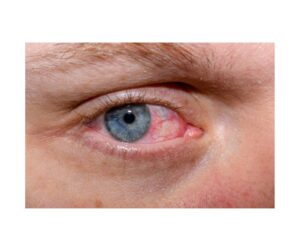Eye flu, medically known as viral conjunctivitis, is a common and contagious eye infection that affects people of all ages. While it is often a self-limiting condition, understanding its causes, symptoms, and treatment can help individuals manage the discomfort and prevent the spread of the infection.


 Causes:
Causes:
These viruses can be highly contagious and easily spread through contact with infected individuals or surfaces. Additionally, other viruses such as herpes simplex virus, varicella-zoster virus, and enteroviruses can also lead to viral conjunctivitis.
Conclusion: While eye flu can be uncomfortable, it is usually a self-limiting condition that resolves on its own. Taking preventive measures, practicing good hygiene, and seeking medical attention, when necessary, can help manage symptoms and prevent the spread of the infection. If you suspect you have eye flu, consult with a healthcare professional for appropriate guidance and treatment.
Table of Contents
ToggleUnderstanding Eye Flu Symptoms: Recognizing and Managing Conjunctivitis
Eye flu, commonly known as conjunctivitis, is an infectious condition affecting the outermost layer of the eye and the inner surface of the eyelids. This highly contagious ailment is characterized by inflammation, redness, and discomfort in the eyes. Recognizing the symptoms early on is crucial for prompt treatment and prevention of its spread. In this article, we will delve into the various eye flu symptoms and provide insights into managing this common eye infection.
Common Symptoms of Eye Flu (Conjunctivitis):
- Redness: One of the hallmark signs of conjunctivitis is redness in the eyes. The blood vessels in the conjunctiva, the thin membrane covering the white part of the eye, become dilated and give the eyes a pink or red appearance.
- Watery Eyes: Excessive tearing is another common symptom. The eyes may produce a watery discharge, leading to a constant feeling of wetness and discomfort.
- Itching Sensation: Conjunctivitis often causes itching in the eyes. Individuals with eye flu may find themselves rubbing their eyes frequently, further exacerbating the irritation.
- Discharge: A thick, yellow or green discharge from the eyes is a typical symptom, especially in bacterial conjunctivitis. This discharge can crust over the eyelashes, particularly after sleep.
- Sensitivity to Light: Photophobia, or sensitivity to light, may develop, making it uncomfortable to be in well-lit environments. This symptom can worsen the overall discomfort associated with eye flu.
- Foreign Body Sensation: Individuals with conjunctivitis may experience a sensation of having a foreign body, like sand or grit, in their eyes. This feeling can contribute to increased eye rubbing.
- Swelling of Eyelids: Swelling of the eyelids is not uncommon in viral or allergic conjunctivitis. This can add to the overall discomfort and affect the normal functioning of the eyes.
- Blurry Vision: In some cases, conjunctivitis can lead to temporary blurry vision. However, this is usually a result of the excessive tearing, discharge, or swelling rather than a direct impact on visual acuity.
Management and Prevention:
- Hygiene Practices: Practicing good hygiene is crucial in preventing the spread of eye flu. Wash hands frequently, avoid touching the eyes with unwashed hands, and refrain from sharing personal items like towels and pillowcases.
- Antibiotic or Antiviral Medications: Depending on the cause of conjunctivitis, a healthcare professional may prescribe antibiotic or antiviral eye drops or ointments. It is essential to complete the full course of prescribed medication.
- Allergen Avoidance: If the eye flu is triggered by allergies, identifying and avoiding allergens can help prevent recurrence. Antihistamine eye drops may also be recommended.
Eye flu, or conjunctivitis, is a common and treatable eye infection. Recognizing the symptoms early on is key to prompt management and preventing its spread. Practicing good hygiene, seeking timely medical advice, and following prescribed treatments are essential steps in overcoming eye flu and restoring eye health.
Understanding and Using Eye Flu Drops for Quick Relief
Eye flu, also known as viral conjunctivitis, is a common and highly contagious eye infection caused by viruses. Symptoms include redness, itching, tearing, and discharge. While viral conjunctivitis often resolves on its own, managing its symptoms becomes crucial for a comfortable recovery. One effective way to alleviate discomfort and expedite the healing process is through the use of eye flu drops.
Understanding Eye Flu Drops:
Eye flu drops, or eye flu medications, are specifically formulated to provide relief from the symptoms associated with viral conjunctivitis. These drops are designed to combat the viral infection, reduce inflammation, and relieve discomfort in the eyes. It’s important to note that these drops are not a cure for the underlying viral infection but are rather aimed at managing the symptoms.
Key Components of Eye Flu Drops:
- Antiviral Agents:
- Many eye flu drops contain antiviral agents that help in inhibiting the growth and spread of the virus in the eye. These agents work to shorten the duration of the infection.
- Anti-inflammatory Agents:
- Inflammation is a common symptom of viral conjunctivitis. Eye flu drops often include anti-inflammatory components to reduce redness, swelling, and irritation in the eyes.
- Decongestants:
- Some eye flu drops may contain decongestants to relieve the feeling of heaviness and promote better comfort.
- Artificial Tears:
- Lubricating agents such as artificial tears can be present in eye flu drops to alleviate dryness and discomfort caused by excessive tearing.
Usage Guidelines:
- Consultation with a Healthcare Professional:
- Before using any eye flu drops, it is crucial to consult with a healthcare professional. They can determine the severity of the infection and recommend the most appropriate course of treatment.
- Proper Hygiene:
- Wash hands thoroughly before applying eye drops to prevent further contamination.
- Dosage and Frequency:
- Follow the recommended dosage and frequency as prescribed by the healthcare professional or as indicated on the product packaging.
- Application Technique:
- Tilt the head back, pull down the lower eyelid, and apply the prescribed number of drops into the eye.
- Complete the Course:
- Even if symptoms improve, it is essential to complete the full course of medication as prescribed to ensure the infection is effectively treated.
Eye flu drops play a crucial role in managing the symptoms of viral conjunctivitis, providing relief and promoting a quicker recovery. However, it is imperative to use these drops under the guidance of a healthcare professional to ensure proper treatment and avoid complications. Practicing good hygiene and following the recommended usage guidelines will contribute to a more effective and comfortable healing process. If symptoms persist or worsen, seeking prompt medical attention is advisable.
Home Remedies for Eye Flu: Natural Treatments to Soothe and Heal
Eye flu, also known as conjunctivitis, is a common condition characterized by inflammation of the conjunctiva – the clear membrane that covers the white part of the eye. While it is typically a viral or bacterial infection, eye flu can also result from allergies or irritants. Although medical intervention may be necessary in severe cases, many individuals can find relief through simple and effective home remedies. In this article, we will explore various ways to treat eye flu at home, providing comfort and promoting a faster recovery.
- Warm Compress:
A warm compress is a simple yet effective remedy for soothing irritated eyes and reducing inflammation. To create a warm compress, soak a clean cloth in warm water, wring out excess water, and place it gently over closed eyes for 5-10 minutes. This helps alleviate discomfort and encourages the natural healing process.
- Cold Compress:
Similar to a warm compress, a cold compress can provide relief by reducing swelling and easing discomfort. Place a cold compress or ice pack wrapped in a thin cloth over closed eyes for short intervals, being careful not to apply it directly to the skin. This can help alleviate redness and soothe irritated eyes.
- Saline Solution:
Rinsing the eyes with a saline solution can help flush out irritants and reduce inflammation. Mix a teaspoon of salt in a cup of warm water, stir until dissolved, and use an eyedropper or cotton ball to apply the solution to each eye. This can be done several times a day to keep the eyes clean and hydrated.
- Chamomile Tea:
Chamomile possesses anti-inflammatory and soothing properties, making it an excellent remedy for eye flu. Brew a cup of chamomile tea, allow it to cool, and use a clean cloth or cotton ball to apply the tea to closed eyes. The gentle application can help reduce redness and irritation.
- Aloe Vera Gel:
Known for its healing properties, aloe vera gel can be applied to the affected eyes to reduce inflammation and promote healing. Ensure that the gel is pure and free from additives. Apply a small amount to closed eyes, avoiding direct contact with the eyeball.
- Cucumber Slices:
Cucumber slices have a cooling effect and can provide relief from eye flu symptoms. Place chilled cucumber slices on closed eyes for about 10-15 minutes. This not only helps reduce inflammation but also refreshes tired eyes.
- Proper Hygiene:
Maintaining good eye hygiene is crucial for preventing the spread of eye flu and aiding in recovery. Avoid touching or rubbing the eyes, and be diligent about washing hands regularly. Replace eye makeup and contact lenses to prevent further irritation.
Conclusion:
While home remedies can provide relief for mild cases of eye flu, it’s essential to consult a healthcare professional if symptoms persist or worsen. Additionally, individuals with severe eye flu, accompanied by severe pain, vision changes, or light sensitivity, should seek prompt medical attention. By incorporating these home remedies into your routine, you can help alleviate discomfort and support the healing process during an episode of eye flu.

